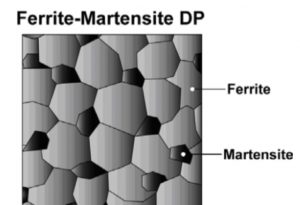The Applications of Advanced High-Strength Steel
What’s the material that is on the forefront of innovation in the automobile industry? If you guessed aluminum or composite steels, you guessed wrong. When it comes to increasing fuel efficiency, quality, affordability, and durability, no material has made more of a difference than Advanced High-Strength Steel (AHSS) and Ultra High Strength Steel (UHSS).
In this and future communications we will begin sharing information about these products.
Advanced High-Strength Steel refers to a new generation of steel that provides high-strength (up to 2,000 MPa) and durability while maintaining formability that is crucial to the manufacturing process.
The primary AHSS grades are produced on high tech Continuous Annealing Lines that provide very high heat followed by a rapid controlled cooling rate of the austenite phase. Further controlled heating and cooling can take place depending on the desired properties.
The difference is this production process and finished microstructure of the steel. Where conventional Low Carbon thru HSLA steel grades exhibit a nearly 100% Ferrite microstructure, AHSS / UHSS steels will exhibit a variety of different microstructures depending on the grade.
The primary types of materials being utilized are Dual Phase, Complex Phase/Multi Phase, Trip, Martensite and Press Hardenable Steel.
Dual Phase Steel
 Ferrite-Martensite dual-phase steel is a low-to-medium carbon material with between 5-50% volume fractional martensite islands that are dispersed in a soft ferrite matrix. In addition to martensite, bainite and retained austenite components can also exist; these are normally produced when improved edge stretch formability is desired.
Ferrite-Martensite dual-phase steel is a low-to-medium carbon material with between 5-50% volume fractional martensite islands that are dispersed in a soft ferrite matrix. In addition to martensite, bainite and retained austenite components can also exist; these are normally produced when improved edge stretch formability is desired.
These variations in microstructure give dual-phase steels a wide spectrum of strength and ductility. DP steels are known to be capable of absorbing large amounts of energy. Combined with a low cost of production, these properties make DP steels highly desirable for automotive applications.
Dual-phase steels can be produced as both hot rolled and cold rolled based material. When Hot Rolled, the rolling temperature and cooling process on the Hot Strip Mill is carefully controlled to produce the ferrite-martensite structure from austenite. When Cold Rolled, the properties are developed on Continuous Annealing lines where there is even greater control over thermal treatment.
Automotive parts that currently use DP steels including but not limited to Crossmembers, Pillars, Roof Rails, Frame Extensions, Shock Towers, Crush Cans and Wheels.
Complex Phase Steel
Complex Phase steels gain their strength through extremely fine grain size and micro structure containing small amounts of martensite, pearlite and retained austenite embedded in a ferrite-bainite matrix. High grain refinement is achieved by precipitation of micro alloying elements such as Nb, Ti or V or retarded recrystallization.
CP steels have a higher minimum yield strength in comparison with dual phase steels of identical tensile strengths of 800 Mpa and greater. When compared to DP steels, CP steels have a much higher yield strength to tensile strength ratio.
Complex Phase steel is being produced as both hot-rolled and cold-rolled which can be hot dipped galvanized for corrosion protection. Hot-rolled products are available in the higher thickness ranges needed to produce structural type parts.
Press-Hardened Steel
Press Hardened Steel or Hot Formed Steels undergo a unique manufacturing process where the […]
